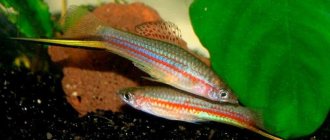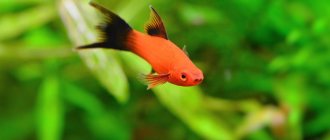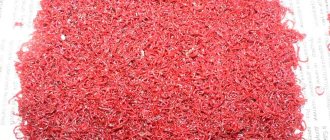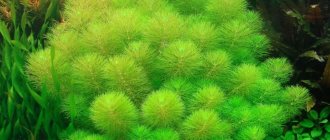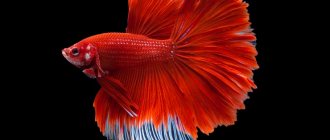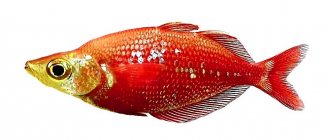Incredibly graceful, bewitching people with the smooth movements of their veiled tails, betta fish instantly attract a person’s attention. There are many varieties of these fish: from single-colored to spotted, pearlescent, also differing in the shape and size of their fins.
All kinds of colors explain their incredible popularity both among aquarium fish lovers and among professional breeders. Despite their fragile and delicate appearance, cockerels have a persistent and rebellious character!
Origin
The homeland of aquarium bettas is distant Southeast Asia. Inconspicuous dark green fish lived in the muddy waters of the rivers of the Kingdom of Siam (modern Thailand). Scientists have found that wild Siamese cockerels live in warm, fresh, often stagnant waters of Vietnam, the Malaysian peninsula and Indonesia.
The first mention of these small fish dates back to the very beginning of the 19th century. Residents of the Kingdom of Siam drew attention to the strong aggression of male cockerels towards each other. As a result of selection, “biting fish” was bred, intended for fighting for money. Such “competitions” became so popular in the kingdom that the ruler of Siam heard about the fish. In 1840, he handed over several specimens for study to the court physician Theodor Cantor, who first registered the found specimens under the name Macropodus pugnax and gave them a classification.
The Siamese cockerel was brought to the countries of the Old World only in 1892. The first individuals were seen by French and German society. The popularity of new pets grew. In 1909, a British ichthyologist who studied Siamese cockerels gave them a new name - Betta splendens (beautiful warrior). Soon, in 1910, the betta fish appeared in the USA. It was brought there by Californian Frank Locke, who, as a result of selection, developed a new subspecies with a short tail in the shape of a semicircle and a new color of cockerels.
Siamese cockerels came to Russia at the end of the 19th century. However, it is not known for certain who brought them to the country. According to the first version, the Russian aquarist of the late 19th - early 20th centuries, V.M. Desnitsky was in Singapore, from where he returned with a large collection of exotic aquarium fish, but no one knows whether there were Siamese cockerels there. According to the second version, Vladimir Stepanovich Melnikov, a former amateur aquarist, at the same time, for the first time in Russia, bred a number of species of labyrinth fish.
Description of the Siamese cockerel
Extravagant and elegant appearance, special grace - this is what the Siamese cockerel can boast of. The fish is part of the ray-finned (or macropod) family of the labyrinthine suborder. That is, each individual has two respiratory organs: gills and a special labyrinthine apparatus that allows the animal to use atmospheric air.
The body of the Siamese cockerel has the shape of an oval, flattened on the sides and greatly elongated in length. Its size is not very large; as a rule, males are slightly larger than females: males reach an average length of 5 cm, and females - 4 cm. However, fish of this species have been recorded reaching 10 cm in length.
The main decoration of this graceful fish is its luxurious fins. The appearance, size, shape of the fin edges and color can vary dramatically among representatives of different breeds. As a rule, the upper and caudal fins have a slightly rounded shape, while the pectoral fins are slightly elongated and pointed.
Sexual characteristics in domestic cockerels are noticeably pronounced. Males are slightly larger than females. Only males have the famous fins that attract the attention of breeders. In girl fish they are several times shorter, not as bright and do not have the same beautiful shape as in boys.
Siamese cockerels have a complex character. They tolerate stressful situations quite calmly, however, when they see an enemy encroaching on their territory, they lose self-control and rush to attack. If the fish does not find any visible enemies, it may “fight” a little with its reflection.
Many people are fascinated by how aquarium bettas swim. They move smoothly, giving the impression that they are gliding along the surface of the water. Boy cockerels swim proudly and majestically, slowly moving their large mantle fins. The girls are practically not inferior to them, but they move more animatedly.
Varieties of betta fish
Modern aquarium fish have come a long way in breeding work. These beauties with amazing outfits are very different from their wild ancestors with a nondescript dull green color and small fins. There are more than 70 different types of betta fish, which are divided into two large groups: by color and by the shape and size of the caudal fin.
So, depending on the colors and patterns, among the Siamese cockerels there are:
- monocolor (one-color individuals) – there are all kinds of color options;
- bicolor (two colors with and without a pattern) - there are breeds in which the body is one color and the fins are another;
- multicolor - the most beautiful are those with a smooth color transition.
Looking at representatives of different breeds, you can see how different these fish can be. Siamese bettas are one of the most successfully bred aquarium fish.
Based on the shape of the fins and body, the following are distinguished:
- The veil-tailed betta is the very first artificially produced variety of aquarium betta. The tail of such fish beautifully “falls” down like a veil;
- Crescent cockerel (Halfmoon) - these cockerels have a large veiled tail fin in the shape of a semicircle, as well as lush upper and side fins. There are several subspecies of halfmoon: half-sun, feathertail, rosetail;
- crowntail - the “plumage” of the fish resembles a royal crown;
- two-tailed cockerel - the tail fin of such fish is divided in half;
- round tail - the tail is small, round in shape, reminiscent of wild relatives;
- brush-tailed or spear-tailed cockerel - the tail is small, characteristically shaped like a brush;
- poster - they have a short, wide tail, as well as a long and wide lower fin;
- delta - the tail of these fish resembles the Latin letter delta;
- royal cockerel - so named because of its large size: from 6 to 8 cm;
- Dragon cockerel - the fish has a massive body with large hard scales, as well as large hard fins;
- elephant ear (Dumbo) - owners of very large circumbranchial fins, similar to elephant ears. Combtail. The fins of representatives of this breed look like a comb.
Social behavior
The name "Fighting Fish" comes from the special behavior between males. They organize fierce battles, but at the same time they are not devoid of nobility. During a fight, when one of the opponents needs to rise to the surface to take a breath of air, the opponent does not attack him, but pauses the fight. If there is another male nearby, he will patiently wait for the fight to end so he can fight the winner, without joining either of the opposing sides. Females are less aggressive, but also have an internal hierarchy, so shelters are needed for weaker individuals. Keeping two or more males together in one aquarium is not allowed; a male can live either alone or in the company of females. This behavior significantly reduces the options for introducing other fish species. Since the male will attack anyone who even slightly resembles his opponent, the neighbors should therefore look opposite both in color and in the size and shape of their fins. Brightly colored fish may be attacked by mistake. An optimal combination is achieved, for example, with Cardinal tetras, Neons and other tetras, as well as with catfish.
Keeping cockerels in an aquarium
Many people who want to get a betta ask the question: “How to care for a betta fish?” In fact, bettas are quite easy to keep and do not require extensive care. One individual needs 3-4 liters of water and a minimum of oxygen.
Comfortable water temperature
The homeland of the aquarium betta is the warm waters of the rivers of Asian countries. That is why it is worth ensuring a sufficiently high water temperature in the home aquarium - 24-28 degrees. The domestic betta fish is a very resilient animal and can easily tolerate temperature drops of up to 20 degrees. However, you should not keep it in cold water for a long time: these small labyrinth fish can get sick. It is important to monitor the temperature in the betta's habitat using a thermometer.
It is also worth maintaining a certain level of acidity (6.0 - 7.5) and hardness (4 - 15) of water in the home aquarium to make the betta more comfortable.
To prevent diseases, improve coloration and reduce stress, breeders should occasionally dilute special salt (half a teaspoon of salt per two to three liters of water), which can be purchased at a pet store.
In order for your betta fish to feel good, you need to regularly change the water in the aquarium: in small ones - after three days, in large ones - after two weeks. You can boil the soil (if it is coarse), and also remove leftover food and other debris from the bottom.
Air for betta fish
Since the betta is a fish of the labyrinth family, it is not very bothered by the presence or absence of an aerator in the aquarium. Bettas are able to breathe both with gills and with the help of a labyrinth apparatus, capturing air directly from the surface. It is best to install a filter of low power: fish do not like strong currents that disturb them.
It is not recommended to heavily plant the aquarium with algae and other plants. Cockerels require access to air; in this case, they will not be able to surface for a portion of oxygen and risk dying.
Be sure to keep the aquarium clean! The betta fish is one of the most demanding inhabitants of the home aquarium. Its contents must comply with the recommendations of professional aquarists. If you do not remove debris or if you use low-quality decorations and equipment, an oily bacterial film may appear at the water's edge. You can get rid of it by simply attaching a piece of paper to it.
Desirable soil
It is very important to choose the right soil and decorate the aquarium. The cockerel requires clean water and is quite picky in choosing a filler. For many people, it doesn’t make much difference how and what to equip the bottom with. An incorrectly selected filler can worsen the condition of the water.
Natural soils include coarse river sand or gravel: they are quite neutral and provide a large area for the development of a colony of beneficial bacteria that process fish waste products. You should not take rolled small marble. It consists of limestone, which is highly soluble in organic acids, which significantly increases water hardness. For decorations, it is not recommended to use real shells, which also increase the content of hardness salts and destroy plants.
Artificial soils are usually neutral, but are made of non-porous material, which reduces the number of beneficial bacteria and leads to the accumulation of waste products at the bottom. For beauty, you should not use white soil: it will quickly turn yellow or green.
Conditions and care
To keep a betta fish you will need an aquarium of at least 10 liters, but larger is better. Comfortable water temperature is 25-28 degrees. At temperatures below 25 degrees, the pet will be lethargic and may get sick. To prevent this from happening, install a thermostat in the jar. To establish balance and mix the layers of water, you will need a filter that matches the volume of the aquarium.
For a comfortable existence, a betta needs living plants. If this is your first aquarium, then choose unpretentious species, for example, hornwort, anubias, Vallisneria nana, cryptocarinae, Java moss. Hornwort can be allowed to float on the surface of the water or attached to glass using a suction cup. Anubias and moss are tied to driftwood or lava. Vallisneria is planted at the back or side wall.
Feeding and diet of betta fish
Betta fish are not particularly picky eaters, so you can feed them with almost any food. Breeders use live, frozen and dry food. However, often, having bought an exotic fish at a pet store, a novice aquarist does not know what, when and in what proportions to feed it. Remember that overeating is much worse for these lively kids than undereating. Excess food not only pollutes the aquarium and harms the coloration of the betta, but also leads to obesity in the pet and the occurrence of various diseases.
In the wild, Siamese bettas are omnivorous fish. They deftly grab stray insects in a jump or at the water's edge, search for ground organisms (benthos) at the bottom, and eat small crustaceans. These fighting fish also don't mind snacking on seaweed or Java moss. That is why more attention should be paid to live (bloodworms, daphnia, zooplankton, brine shrimp) or frozen food than to dry food.
Dry food can be given less often, since protein food is more necessary for bettas. This food should be given to the fighting fish alternately:
- standard dry food flakes: you need to give them little by little, as much as the individual can eat in two minutes;
- granules for bettas: this food is designed specifically for this type of fish, so all the beneficial substances in it are balanced;
- dry bloodworms and brine shrimp: even the most picky fish will like this delicacy.
Frozen food is the same as live food, but much safer. The fact is that purchased larvae or worms can be contaminated and cause betta disease. Therefore, it is better to process the treat before feeding.
Diet is also important. Young fish should be given food in small portions once or twice a day. As they grow older, you can feed them less often. An additional portion can be given only if the bettas ask for it themselves. During the spawning period, as well as the fry, they are fed twice a day. It is useful to give your cockerels a fasting day once a week. The fish’s body will have time to get rid of accumulated toxins, and the digestive system will recover.
Compatibility of betta fish
Bettas are lively and cocky pets who find it difficult to get along even with their own kind. The male will never be able to calmly endure the existence of another - constant fights will begin. However, this does not mean that these fighting fish have to live alone. Other residents of the spacious aquarium will help recreate the animal’s natural habitat and improve its well-being.
It is very important to choose the right neighbors with whom the betta fish can easily get along. Species whose representatives are quite peaceful and do not have large (more than 5 cm) body sizes are well compatible with bettas. These include guppies, swordtails, neons, gouramis, cardinals and speckled catfish.
You should not add fin-picking fish, such as dwarf tetradons, to your bettas. However, bettas themselves are not against biting off the “clothing” of their beauty competitors. Aquarium bettas sometimes mistake veiled fish of other species for representatives of their own, so they rush to attack.
Also, you should not keep cockerels with large predators. Cichlids, Astronotus, Polypterus - all of them often mistake small fish for food, and a small cockerel with its large fins will become the subject of aggression in the first place.
It is best to place fish in an aquarium from a young age. In this case, they will be able to get used to each other, and there will be much less fights and skirmishes. If a betta fish's neighbor dies, you should not introduce another fish in the near future - the betta may kill it.
You can share two or three females with one male aquarium betta to make him feel calmer. Make sure their home has enough space for betta girls to hide.
The fish will feel comfortable in a spacious tank (volume more than 50 liters). If there are a lot of decorations and plants in the aquarium, then territorial disputes between its inhabitants will not arise.
Breeding
It's not as difficult as you might imagine. It does not require special preparation or recreation of natural conditions. With the right approach, it is possible to get offspring even in a community aquarium. The most difficult thing is not even the spawning itself, but the selection of parents.
Cockerels are picky, and if the male does not like the female, he may even kill her. Therefore, several females should be purchased for one male.
These fish are able to bear offspring as early as 3 months. From this moment you can proceed directly to breeding. You will need a small container (no more than 10 liters in volume) into which 10-15 cm of water is poured. No soil is needed, only shelters for the female are needed. Snags, stones, and branched plants that create dense thickets (for example, riccia or hornwort) will do.
In addition, floating plants will be needed as these are used by the male to create a nest. They are not difficult to find. The most popular of them are pistia or swamp duckweed. Many aquarists throw them away in bags due to their rapid growth. Therefore, if these plants are not available, then it is enough to ask for them in various social media pages. networks and forums.
The temperature is approximately the same, 26-30°C. It is advisable to use soft water. If hard water flows from the water supply, it can be pre-frozen and thawed, making it thawed, and then the hardness indicator will decrease by approximately 50%. In addition, there is a special chemistry containing peat.
2 weeks before spawning, the parents are seated and heavily fed, preferably bloodworms and brine shrimp. Then the male is placed in the spawning tank. If he gets used to it and builds a so-called foam nest, then you can throw a female with eggs to it. It is not difficult to understand when a fish begins to spawn - its abdomen becomes swollen and rounded.
To speed up the process, spawning is stimulated artificially. To do this, they make changes, soften the water, raise the temperature, etc. If this does not bring results, then it is better to take another female. While the parents are in the spawning area, feeding should be stopped.
The male is placed first in the spawning tank. Having got used to it, he begins to build a so-called foam nest.
Spawning is an interesting spectacle. The male carefully squeezes several eggs out of the female’s abdomen. They fall, after which the “father” picks them up with his mouth and picks them up, placing them in his nest. This procedure is repeated until the eggs run out. When everything comes to an end, the female swims away for cover, and the male circles over his nest.
The “mother” can already be removed, since after the eggs are released, she is a threat to the fry, and accordingly, the male can kill her. Therefore, only one parent remains in the spawning area, which guards the eggs. A day later, larvae will appear from it, and a day later they will be able to move independently.
From now on, parents are not needed at all. The main thing at this stage is varied and enhanced feeding. The fry can be fed with live dust and ciliates. After 4 days, the diet can be changed to brine shrimp. After 2 weeks they begin to give regular food.
Reproduction
Like all labyrinth fish, aquarium bettas are endowed with a very interesting, but not very pleasant feature. Females quite often collect eggs, which become denser over time, forming a cyst. Because of this blockage, which is almost impossible to get rid of, the fish is unable to spawn and may even die. This is why it is important to spawn batte occasionally. And if you want to breed these beautiful fish, it’s quite easy to do.
Cockerels reach sexual maturity quite quickly, at about three to four months. However, it is worth taking a couple of six to eight months for breeding. The male, who has spawned many times, has noticeably large fins.
Watch a video about breeding cockerels:
Despite the fact that a couple is capable of building a nest in a common aquarium, it would be better to transplant them into a separate one - only then will it be possible to get offspring. For a spawning tank, a small one (four to five liters) with a water level of 10-15 centimeters is sufficient. It is not necessary to add soil to it, but more vegetation should be placed. In them, the female will be able to hide from the male, and he, in turn, will build a nest from algae. It is important to maintain a high water temperature in the aquarium (28-30 degrees). The couple is fed with different live food.
After the male builds a foam nest, the cockerels dance begins. The girl fish swims upside down and lays eggs in the constructed house, and the male fertilizes her. After this, the female is placed in the main aquarium, and the male remains to look after the nest, removing dead eggs and returning the fallen ones to their place. The day after spawning, larvae appear, and four to six days later, fry appear. Then you should remove the male, who will try to return the babies to the nest.
For fry, it is necessary to establish aeration in the aquarium, since their labyrinth apparatus has not yet formed. Babies should be fed ciliates or heavily washed bloodworms or tubifex.
Owner reviews
gruz
Until recently I had a male betta. He was handsome, his fins and tail were long and fluffy. It was blue. My cockerel lived for literally three months. He ate everything that everyone else did and wasn’t picky. And at one fine moment he probably became bored, because he has an obstinate character by nature, since all the other fish are larger than him, my rooster found his opponent in the form of his reflection in the glass. Started to fight with him. He fought for four days, became all fluffy, taking on a fighting appearance. Then, apparently, he became upset that he was “not being defeated” and died, apparently from grief. It’s not for nothing that the betta is called a “fighting fish,” and you can’t put two males in one aquarium. This is such a strange fish. But very beautiful!
VIKA0712
The cockerel fish is truly gorgeous, with a bright color. When she swims imposingly in the aquarium, it’s impossible to take your eyes off! She is not particularly picky about food or care. Holding such a fish is a pleasure. The only problem is that you can’t add other fish to the bettas in the aquarium and they themselves fight among themselves for leadership, gnawing off each other’s fins and tails and then dying. Without knowing all this, we added the cockerel to the fish in the aquarium, he killed everyone and was left swimming alone in the aquarium. Thanks to an irresponsible seller who did not warn us, we were left without fish. What a sad story!
Redwall
I am an aquarist with 8-10 years of experience. During this time, all kinds of fish lived with me. We also had experience with cockerels. There's a reason they're called fighting fish!
A couple of years ago I had a 60 liter aquarium with goldfish, macropods, neons and two bettas. At first, the two cockerels got along well, but then one began to behave extremely aggressively: he began to eat the fins of the other. As a result, they constantly pursued each other. A month later, the prey fish died.
The actions of the betta fish did not stop there. He switched to the fins of other fish. Now the cockerel and the macropod have declared war on each other: they began to eat each other’s tails. But the rest of the fish suffered a little: the cockerel ate their tails too. As a result, we bought a separate aquarium, where the cockerel was moved.
By itself, he is a slow fish, unpretentious, very beautiful! Doesn't require much space. But if you place him with other fish, then be careful: the fish can show a fighting character and justify its second well-deserved name. I recommend it for beginner aquarists.
irinich
When I saw the cockerels for the first time, I couldn’t resist buying such a beauty. In the aquarium there were barbs, neons, a couple of catfish, and crayfish. The store assured that the cockerel would live peacefully with all these fish. I took one to try. As soon as he was launched into the aquarium, he immediately began chasing neons and barbs. He bit off their fins and tails. I didn’t really get into trouble with the catfish, but I tried. He also showed particular aggression towards the crayfish, but the crayfish was purple. As a result, after a week, almost all the fish had their tails bitten, so the cockerel had to be isolated and then taken back to the store. In general, the fish turned out to be pugnacious, so if peaceful fish live in the aquarium, it is better not to buy a cockerel.
Dme
Cockerel is truly a very beautiful fish. The unpretentiousness of these fish can only be compared with goosefish. In a small aquarium you can keep one fish for quite a long time. There are no special requirements for the composition of water or feed. But these fish have a very serious drawback. They cannot get along with any other inhabitants of the aquarium. By nature, aunties are fighting fish. I had the imprudence to put a cockerel in an aquarium with goops and swordtails for two days.
During this time, the cockerel tore off the tails of almost all the inhabitants of the aquarium and drove them into thickets of aquatic plants. He took up a strategic position near the feeder and carefully made sure that no one could swim past. Of course, I immediately put it in a separate container as soon as the opportunity arose. If you want to get yourself such a fish, then you need to keep the cockerel alone or be prepared for the fact that all the other inhabitants will be without tails.
Korica
Representatives of this breed can be very beautiful, bright and graceful. But they are fighting fish and therefore the beauty of these fish cannot be used in large quantities. The territory of the aquarium must belong to one male of this species, otherwise fights without rules cannot be avoided. They can also attack other veil-tailed fish, mistaking them for a rival.
The females of these fish are also constantly in tension with other neighbors. The ideal option for a betta is a small aquarium planted with plants, in which one male and two or three females will live. And maybe you will be lucky to see the love games that these fish have, which are mesmerizingly beautiful; and watching how the male takes care of the clutch is very touching. For those who love slow-moving fish and are simply amazed by the beauty of the betta, you just need to consider their temperament and continue to enjoy your pets!
Video
How long do they live (disease prevention)
Betta fish live relatively short lives - 2-4 years. In order for your pet to feel good and look beautiful, you need to pay attention to how the fish feels. Diseases can significantly reduce the life expectancy of a betta, so it is necessary to regularly prevent the disease, and at the first noticeable symptoms of illness, begin treatment immediately.
To reduce the chance of fish getting sick, you need to keep your aquarium clean. It is also worth monitoring the quality of live food. Under no circumstances should you throw it into the aquarium along with the water in which it was kept. Treat the feed. To prevent diseases, it is recommended to regularly give vitamins to aquarium bettas.
It is quite easy to notice that a betta is sick. Sick males are less active, swim sluggishly, and try to hide. Also pay attention to their fins: sound the alarm if there are holes in them or if the animal is holding them to its body. Symptoms of some diseases include raised scales, spots on the body, breathing problems and a bloated body.
If these signs are detected in a fish, it is necessary to urgently isolate it and begin treatment.
Watch a detailed story about the cockerel:
Nutrition
The aquarium betta fish is prone to obesity, so overfeeding it is not recommended. Betta fish should be fed 1-2 times a day, and the amount of food should be given exactly as much as the fish can eat in 15 minutes. Food can be live, dry or frozen. Remains of uneaten food are removed.
Zooplankton, bloodworms, tubifex, artemia, daphnia, and earthworms are used as live food for cockerels. Dry food is available in the form of flakes and granules, created specifically for bettas. To avoid gastrointestinal diseases and excessive water pollution, preference should be given to live and frozen food.

